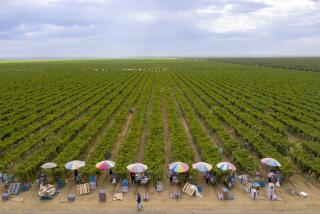Farm Workers Urged to Stand Up, Be Counted
Simi Valley resident Porfirio Hernandez has labored in this country for more than 40 years, picking crops and cutting lawns to support himself and his family.
But in all those years, the 66-year-old laborer has never been counted.
Hernandez is exactly the kind of person that the U.S. Census Bureau is looking for as it steps up an unprecedented campaign to ferret out those traditionally overlooked during the decennial head count.
Bearing Mexican sweetbread and strong coffee, census workers tracked down Hernandez last week in the parking lot of a Moorpark convenience store, where dozens of men gather every morning before dawn to hunt for jobs as gardeners and construction workers.
They urged him to take part in this census, assuring him that the information would not be shared with federal immigration officials or the Internal Revenue Service.
They told him that every completed census form translates to more dollars for migrant health clinics, housing programs and job training programs.
*
And they told him that it was his right, if not his responsibility, to stand up and be counted.
“They say it will be good for my family and my community to participate,” said Hernandez, who despite coming to the United States decades ago during the bracero guest-worker program had never heard of the census. “It seems like a good thing to do.”
Census workers say laborers like Hernandez illustrate the critical need to step up outreach efforts as the 2000 census draws near.
Farm worker advocates estimate that as many as half of the state’s migrant and seasonal farm workers went uncounted during the 1990 census.
It’s because in many poor, immigrant communities, residents often lack education, speak little or no English and live in nontraditional housing, such as converted tool sheds and garages.
Add to that the transitory nature of farm work and day labor, and it makes the enumeration even harder.
In Ventura County, the local census office has been working since last year to increase awareness, especially in hard-to-count communities.
Census officials have been advertising on television and radio, visiting schools and civic groups and developing partnerships with community groups to prepare the way for census forms and census takers to arrive this spring.
Last month, the Ventura office created a two-person task force to spread the word to farm workers and other laborers.
“We want them to know that it’s safe to be counted,” said David Sosa, 20, a lifetime Oxnard resident and task force member. “They have a lot of interest in what we’re telling them. A lot of them know it’s going to help them in the long run.”
The campaign hit a snag last week when some members of the farming industry expressed concern about census workers coming onto their properties and disrupting production.
Rob Roy, president of the Ventura County Agricultural Assn., told census officials that it would be better if census takers waited to approach workers as they were leaving work for the day.
Upon hearing those concerns, Census Bureau officials agreed to adjust the operation.
“We just felt there were less intrusive means of accomplishing what the Census Bureau wanted to accomplish without them taking access to the fields,” said Roy, who agreed to tell members of his association to encourage workers to participate in the census.
Steve Alnwick, assistant regional manager for the Census Bureau, said census workers can accomplish their goals by meeting with field hands after work or at other places they congregate.
The most important thing, he said, is that the outreach effort continue.
“We are not pulling the plug on our promotional outreach,” Alnwick said. “We need to continue to reach out to migrant workers and talk to them about the importance of the census.”
Rep. Elton Gallegly (R-Simi Valley), who connected Roy with Census Bureau officials, said he is happy the two sides reached an understanding.
He said an accurate count is not only critical to the census, but vital to Ventura County and the state.
“I don’t care what a guy’s last name is or where he came from--if he’s here he should be counted,” Gallegly said. “It’s critical to find ways to ease folks’ minds that participating in the census is not going to complicate any other part of their lives.”
Indeed, the census is thought to have missed millions of people nationwide 10 years ago, including 12% of Native Americans, 5% of Latinos and 4% of blacks.
School-age children, the homeless, renters, recent immigrants and farm workers are among those vastly undercounted.
Those oversights carry serious consequences.
Information generated by the census is used to determine federal, state and local legislative districts. The numbers also help determine how much federal money is spent in local communities on everything from public schools to road construction.
Undercounts are believed to have cost California one congressional seat and millions of dollars in federal money for such services as health care, education and housing assistance during the past decade.
To ensure the most complete count possible, the Census Bureau is joining with groups such as California Rural Legal Assistance to focus on specialized populations, including migrant farm workers.
The statewide poverty law firm was awarded a $500,000 grant to boost its outreach efforts in rural areas, including Oxnard.
In the firm’s Oxnard office, outreach worker Antonio Flores has been hired to reach out to the most marginalized farm worker population--Mixtec Indians, who represent a growing percentage of the county’s agricultural work force.
Mostly indigenous inhabitants of the highland villages of central and southern Mexico, the Mixtecs maintain their own language and often arrive in the U.S. speaking little or no Spanish, let alone English.
As a result, studies show they are among the lowest paid, most frequently exploited and most impoverished workers in the U.S.
A Mixtec Indian himself, Flores attempts to track down members of that indigenous community and assure them that they won’t be deported for participating in the census and that any information they give is confidential.
Santos Gomez, lead attorney for the Oxnard office, said the hope is to alleviate some of the distrust they may have in government. “Our message is if you’re here on April 1, you need to be counted.”
It’s a message that sits well with census worker Rosa Martinez-Sotelo, who has put more than a year of time and energy into census awareness and education.
That’s why she was in Moorpark last week, well before first light with a box of sweetbread, as laborers began gathering on the street corner to search for work.
Along with other census workers, Martinez-Sotelo, daughter of an El Rio packinghouse worker, passed out fliers and told workers not to be afraid to take part. She told them they would soon receive letters allowing them to request census questionnaires in Spanish, Chinese, Vietnamese, Korean and Tagalog. And she assured them that the forms would take only a few minutes to fill out.
She also told the day laborers that the Census Bureau is going to need extra workers--700 in Ventura County alone--once the head count swings into head gear. Census jobs pay from $8.25 to $18.50 an hour.
That has plenty of appeal to Marcos Zacarias, a 21-year-old Moorpark resident who watched with dozens of other laborers as only a handful of employers arrived to hand out jobs on a recent morning.
A native of Mexico City, Zacarias said he’s eagerly looking forward to participating in his first census. And he said if he got a job with the Census Bureau, he thinks he could make others excited as well.
“We can’t be scared about it,” he said. “We’ve got to be counted so we can get more benefits, more education for our community. I don’t know anyone out here who wouldn’t want that.”
More to Read
Sign up for Essential California
The most important California stories and recommendations in your inbox every morning.
You may occasionally receive promotional content from the Los Angeles Times.










